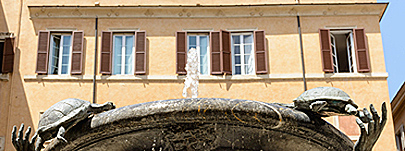
From left to right the mains sight you can see are: the Church of Jesus (main Church of the Jesuite order), Palazzo Mattei (the prominent palace in the forefront), the whitish and sumptuous Vittoriale (dedicated to King Victor Emmanuel II, first king of the reunited Italy, ended in 1911, it hosts the unknown soldier of WW1, so it is called also Altare della Patria, or Altar of Fatherland). After it you see the medieval brickwork Church Ara Coeli (Altar of the Sky), standing where there once was the Temple of Juno. You see then the imposing palace with a clock tower, which is the seat of Rome Municipality, right on top of the Capitoline Hill (Campidoglio in Italian), followed by the Palatine Hill. Then, in the forefront, you see the Church of Santa Maria in Campitelli, and the Abbazia of Sant'Ambrogio (St. Ambrose Abbey). You can see then in the distance the Alban Hills or Castelli Romani, and closer, if you are a good viewer, the ancient Theathre of Marcellus, on top of which some homes were built in the Middle Ages. Please also see the 3rd view below for a closer view. You can see then the large dome of the Main Jewish Synagogue ("Il Tempio"), followed in the distance by the Aventine Hill and its San Saba Church, and in the foreground, the trees flanking the river Tiber.
Towards North-West, from left to right you see first a procession of domes: the Church of Sant'Andrea della Valle of the Teatine Order is the 2nd highest in Rome after St. Peter's. You see then the Ch. Sant'Agnese (St. Agnes), by Rome's most genial architect Francesco Borromini, which faces Piazza Navona. Between its dome and its right belfry you can see in the distance the pointed belfry of the Ch. Santa Maria dell'Anima, an Italian Renaissance church nowadays the church of the German community in Rome. Just after you see the Monte Mario hill, Rome's highest with the Janiculum, although both are not included in the famous 7 hills. It hosts an Astronomical Observatory, and at its feet one finds the Olympic Stadium (not visible in the photo). Next comes the Palace of the High Court of Justice, surmounted by its imposing quadriga, dubbed by Romans "Palazzaccio" (ugly palace, because it is pompous and it doesn't appeal to the Italian taste). You see then the spiral dome of the Ch. St. Ivo alla Sapienza, another marvel of F. Borromini, two turrets one of which belongs to the Germanicum, the institute forming German priests, followed by the flying saucer shape of the dome of the Pantheon. Its architect was emperor Hadrian, and it is the best preserved ancient monument in the world, and still the largest dome in Rome (43.3 Mts), larger than St. Peter's. To its right you can see the dome of the Ch. of San Carlo al Corso, and in the distance, the pine trees of the Borghese Gardens. You can also see the top of the Ch. of Sant'Ignatius of Loyola (founder of the Jesuites), followed by the dome of the Ch. of Jesus (Chiesa del Gesu') the main church of the Jesuite order. To the right of the dome you can see the top part of Palazzo Quirinale, one of Europe's largest palaces, formerly the town palace of the Popes, and now of the Italian President of the Republic. Finally you can see Palazzo Mattei, a famous historical aristocratic palacei
From left to right, you can see: first sights described in the first photo (please read there): Church of Santa Maria in Campitelli, Abbey of Sant'Ambrogio, Alban Hills or Castelli Romani, the Theatre of Marcellus surmounted by homes built in the Middle Ages. One can see here however more clearly that the Alban Hills gradually slope down, encircling the Lake of Albano, and in the ridge of the Lake, with binoculars, you can see the summer residence of the Pope in Castel Gandolfo. Amidst the trees you can also see the F.A.O. palace (Food and Agriculture Organization) of the United Nation, formerly the Italian Ministry of Colonies, donated by the Italian State to the U.N. You can see then some buildings of the Aventine, and then the imposing, quadrangular dome of the Main Jewish Synagogue, called "Tempio Maggiore" (Major Temple) by Roman Jews, by architects Costa and Armanni (1904, after the liberation of the Ghetto, occurred in 1870 with the new Italian Union). After it you can see the imposing religious compound of San Saba in the Aventine Hill, together with the compound of Villa Malta, hosting the international headquarters of the Knights of Malta. After it, you see the Gasometro, formerly supplying gas to the characteristic working class quarters Testaccio, Ostiense and Garbatella near it. In the distance you can see the profile of magnificent Colosseo Quadrato (Square Coliseum) of the EUR, the quarter built for the Universal Expo of Rome of 1942, which was never held because of the war, and which was transformed after into a posh, green residential area. Other sights of the EUR can be seen from the terrace, from other points (the dome of the Church St. Peter and Paul at the EUR, its new high rise buildings etc.). For a detailed presentation of the rooms, please go to the INDEX on top of this page
Visit Rome | Rome panoramic views | Rome apartments and villas | Inquire | Rome travel guide | Rome map | Service | Resources Roman Homes homepage |
